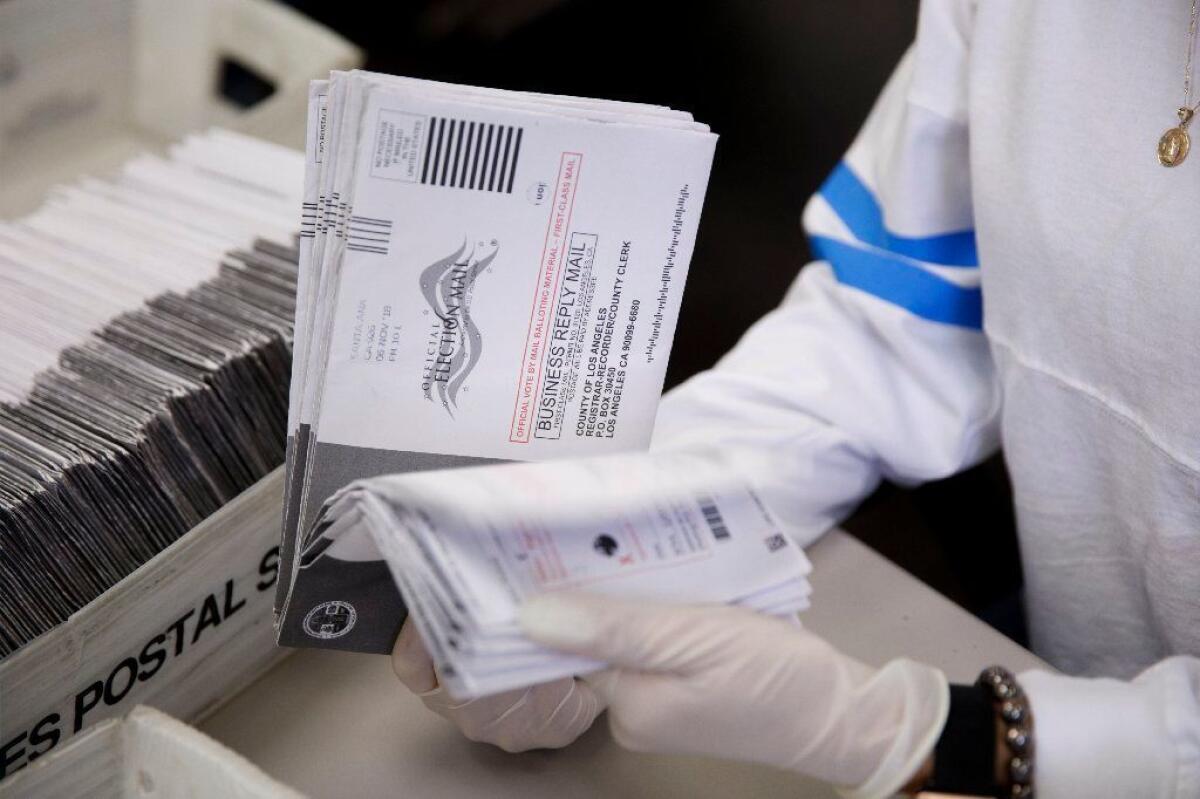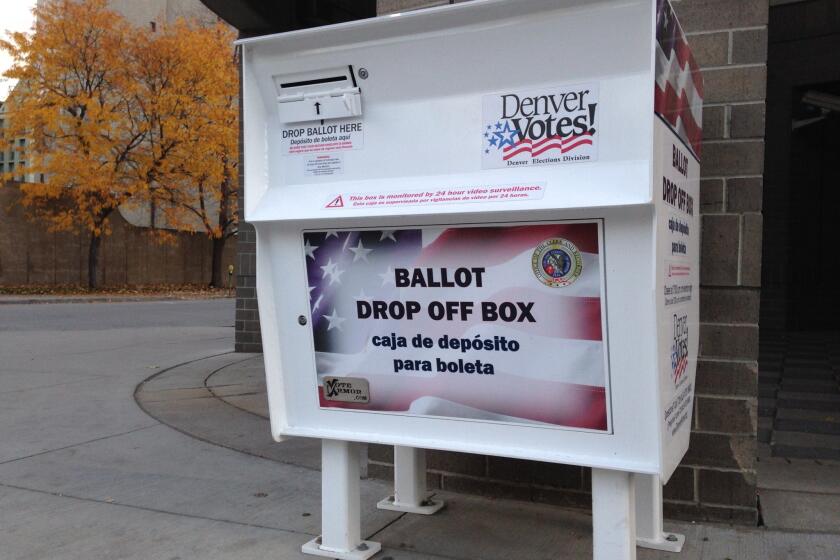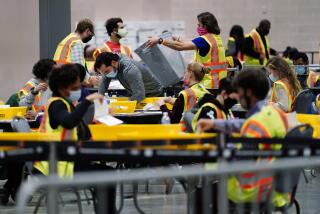Trump claims without evidence that mail voting leads to cheating: A guide to facts on absentee ballots

- Share via
President Trump escalated his unsubstantiated attacks on mail voting Monday, claiming with no evidence that expanding the practice would lead to foreign governments printing counterfeit ballots and cause the “election disaster of our times.”
“Because of MAIL-IN BALLOTS, 2020 will be the most RIGGED Election in our nations history - unless this stupidity is ended,” Trump tweeted. “We voted during World War One & World War Two with no problem, but now they are using Covid in order to cheat by using Mail-Ins!”
Election officials pushed back on the president’s assertions. “We are not aware of any evidence supporting the claims made by President Trump,” the National Assn. of Secretaries of State said in a statement. “As always, we are open to learning more about the Administration’s concerns.”
The president’s latest string of criticism comes as states are weighing the pros and cons of expanding voting by mail — which five states use exclusively and all states allow to some extent — to prevent the spread of the coronavirus at polling places during the primary season and the November general election.
Health officials recommend expanding absentee voting to allow people to stay home from the polls, but political and financial concerns have complicated the shift.
It may not be safe to go to the polls in November. There is still time for states to switch to a mail-in ballot nationwide, but not much, and some states continue to resist.
Some Republicans have argued that voting by mail will lead to increased fraud, though there is no evidence that mail voting has led to systematic abuse.
“When state governments start adopting these practices like mail-in ballots, that open the floodgates of potential fraud, then people’s confidence in the outcome of the election is going to be undermined,” Atty. Gen. William Barr said Sunday on Fox News’ “Sunday Morning Futures.”
Barr, a Virginia resident, voted by mail in 2012 and 2019, according to the Washington Post. Trump has also voted absentee, including in Florida’s March presidential primary.
Trump’s criticism of mail voting ahead of the November general election echoes his unsubstantiated claims that millions of people voted illegally in the 2016 election, in which he won the electoral college but lost the popular vote to Hillary Clinton by nearly 3 million. In May 2017, he created an advisory panel to investigate election integrity; it did not find evidence of widespread voter fraud.
Trump openly stated in April that he was considering GOP chances in his opposition to mail balloting. Republicans “should fight very hard when it comes to state wide mail-in voting,” he tweeted, because it “doesn’t work out well for Republicans.”
The Republican National Committee has committed to spending $20 million to block Democratic-led efforts to expand mail voting.
“My biggest risk is that we don’t win lawsuits,” the president told Politico on Thursday. “We have many lawsuits going all over. And if we don’t win those lawsuits ... I think it puts the election at risk.”
Though the political debate over mail-in ballots is unresolved, absentee voting has been on an upward trajectory for the last two decades as election officials in both parties embraced the practice. In 2016, 21% of general election ballots were cast by mail, compared with 7.8% in 1996, according to the U.S. Census Bureau.
Five states — Colorado, Hawaii, Oregon, Washington and Utah — conduct all elections primarily by mail. The coronavirus outbreak could push more states to join them.
How widespread is mail voting?
Every state offers some form of absentee voting.
According to the National Vote at Home Institute, 16 states allow absentee voting only with an excuse (for instance, if someone is away on military service, at school or, in some states, over the age of 65); 24 states offer no-excuse absentee voting but require voters to apply for a ballot; five states and the District of Columbia allow voters to apply for absentee ballots and permanently receive them (Virginia will join this category in July 2021).
What’s the case for expanding vote by mail?
Proponents of expanded mail ballot options say remote voting is more convenient for voters, cheaper for states and leads to a slight uptick in turnout.
In the midst of the coronavirus outbreak, absentee ballots are seen as a way to reduce the risk of spreading the disease at polling places. An April NBC poll found that 58% of Americans support allowing vote by mail generally, and an additional 9% support vote by mail as a one-time exception for the November 2020 election. But 29% of voters oppose vote by mail generally and for the upcoming election.
Would mail-in ballots delay election results?
If there is a massive shift toward mail voting before the November general election, it’s possible that the results of the presidential vote won’t be known on election night. In California, this has led to situations in which Republicans have led in close races on election night, only to see the lead change as more ballots are counted. (Historically, many Democrats have tended to vote on or just before election day, meaning their preferences are not reflected in the earliest tallies.)
Some have expressed concerns that the president is laying the groundwork to question the results, particularly if later ballots — received in the mail after election day — help former Vice President Joe Biden pull ahead.
“It’s quite possible that President Trump could be ahead in the count on election night, but as millions of additional ballots are counted over the next few days the lead could shift to Biden,” UC Irvine law professor Richard Hasen told CNN last month. “And Trump, who has been making unsubstantiated claims of voter fraud for years, has now started shifting to making these claims about mail-in balloting, and he could certainly claim that there’s something wrong about how the vote count was done.”
Is there a risk of voter fraud?
Critics of remote voting say ballots could be mailed to inactive voters, people could vote more than once (via absentee ballot and in person) or voters could be intimidated into voting a certain way outside the privacy of the voting booth.
But experts say cases of voter fraud have been few and far between over the last few decades.
A database organized by News21, an investigative news project based out of the Walter Cronkite School of Journalism and Mass Communication at Arizona State University, found 2,068 cases of alleged voter fraud between 2000 and 2012. (Most allegations did not lead to convictions.) Absentee ballot fraud accounted for 491 cases out of hundreds of millions of ballots cast.
Oregon, which has held all elections by mail since 2000, has only seen two criminal convictions for mail ballot fraud in the last two decades.
“With well over 50 million ballots cast [in Oregon], there have been only two fraud cases verifiable enough to result in convictions for mail ballot fraud in 20 years,” Amber McReynolds of the National Vote at Home Institute and Charles Stewart of the MIT Election Data and Science Lab wrote in an op-ed for the Hill news publication. “That is 0.000004 percent — about five times less likely than getting hit by lightning in the United States.”
From the outset, it was a spirited battle between two Cuban-born politicians with deep roots in the city.
In 2019, North Carolina was forced to call a new vote for the 9th Congressional District after an operative for Republican Mark Harris, the victor in the general election, was charged with illegally collecting ballots from voters.
In Utah, election officials told the Salt Lake Tribune that the fraud they do encounter comes in the form of members of the Church of Jesus Christ of Latter-day Saints filling out ballots for children on mission trips abroad, or spouses signing for one another. Officials said they catch those cases when they compare the signature they have on file for a voter with the one on the ballot they’ve received.
What about the foreign interference Trump and Barr warn about?
Trump and Barr have warned that foreign governments “could easily make counterfeit ballots, put names on them, send them in,” as Barr said in a recent interview.
Election officials from both parties in states that use mail-in ballots say that’s not possible. Election laws vary by state, but officials have several tools to prevent and detect attempted absentee voter fraud.
Several states compare the signatures on mail-in ballots and an individual’s voter registration, use bar codes to track ballot processing and provide secure drop box locations. States can also conduct postelection audits of the results. Such an audit helped detect the 2018 absentee ballot fraud case in North Carolina.
Does one party benefit from mail-in ballots over another?
Both parties have concerns about how expanded mail voting would affect election outcomes. While Republicans worry that easier voting would boost Democratic turnout, some Democrats worry that Black and Latino voters are less likely to adopt vote by mail.
A Stanford University study released in April on the rollout of vote-by-mail programs in three states — California, Utah and Washington — found that absentee balloting didn’t increase one party’s overall turnout or vote share more than the other’s between 1996 and 2018, but modestly increased overall voter turnout.
The study acknowledged that voter data collected before the COVID-19 outbreak may not predict what would happen during a shift to all-mail elections during a pandemic. But it establishes that fears from both parties about vote by mail aren’t accurate, according to the Stanford team.
“Claims that vote by mail fundamentally advantages one party over the other appear overblown,” the study said. “In normal times, based on our data at least, vote by mail modestly increases participation while not advantaging either party.”
In California’s May 12 special election runoff for a congressional seat in the Los Angeles suburbs, Republican Mike Garcia won by nearly 10 percentage points — in an election where 97% of ballots were cast by mail.
Is it feasible to expand mail voting by November?
It’s one thing to back expanding mail voting. It’s another to support rapidly expanding the process in a few months, considering that states with all-mail elections took years to transition.
“I don’t think it’s a realistic goal to think that you could get 50 states to all be vote by mail by even the November election just because the states are in such wildly different places,” Kim Wyman, Washington state’s Republican secretary of state, told the New York Times in April.
The CARES Act provided the Election Assistance Commission with $400 million to provide grants to states “to prevent, prepare for, and respond to coronavirus, domestically or internationally, for the 2020 Federal election cycle.” Outside groups estimate that the cost of helping states fund the expansion of vote by mail and the sanitization of polling places would cost at least $2 billion.
How are the political parties reacting?
There has been a wave of litigation across the country on expanding mail voting and changing the rules that govern the process. Republican and Democratic organizations have sparred with election officials across the country over election rules on allowing “ballot harvesting” by local organizations, ending requirements for a witness signature on absentee ballots, and allowing ballots to be counted if they’re postmarked on or before election day.
The Republican National Committee doubled its litigation budget to $20 million last month, with a focus on blocking Democratic efforts to expand mail voting. The committee has sued or intervened in cases in about a dozen states on remote voting issues. Last month, the committee joined a suit against California Gov. Gavin Newsom over his executive order to send absentee ballots to all registered voters in the state.
In Nevada, after officials announced the June 9 primary would be conducted by mail, True the Vote, a Texas-based voting group, sued on behalf of plaintiffs who argued the secretary of state’s plan would dilute their vote by allowing voter fraud. A federal judge ruled against them.
“The Court finds that Defendants’ interests in protecting the health and safety of Nevada’s voters and to safeguard the voting franchise in light of the COVID-19 pandemic far outweigh any burden on Plaintiffs’ right to vote, particularly when that burden is premised on a speculative claim of voter fraud resulting in dilution of votes,” U.S. District Court Judge Miranda Du wrote.
More to Read
Get the L.A. Times Politics newsletter
Deeply reported insights into legislation, politics and policy from Sacramento, Washington and beyond. In your inbox three times per week.
You may occasionally receive promotional content from the Los Angeles Times.












